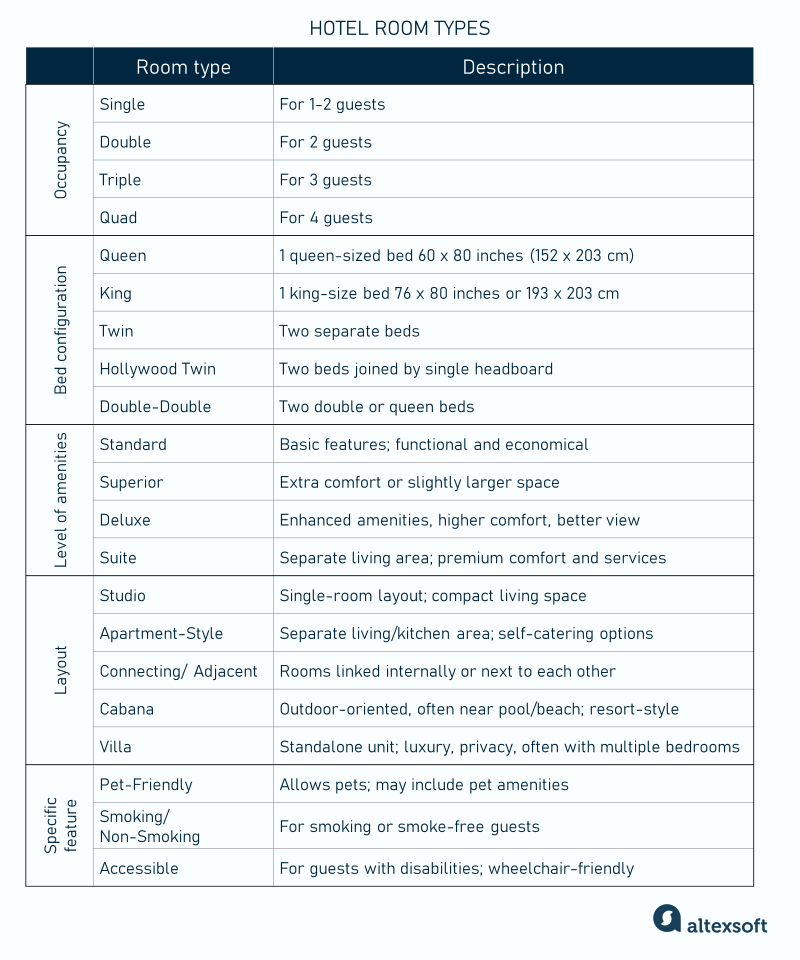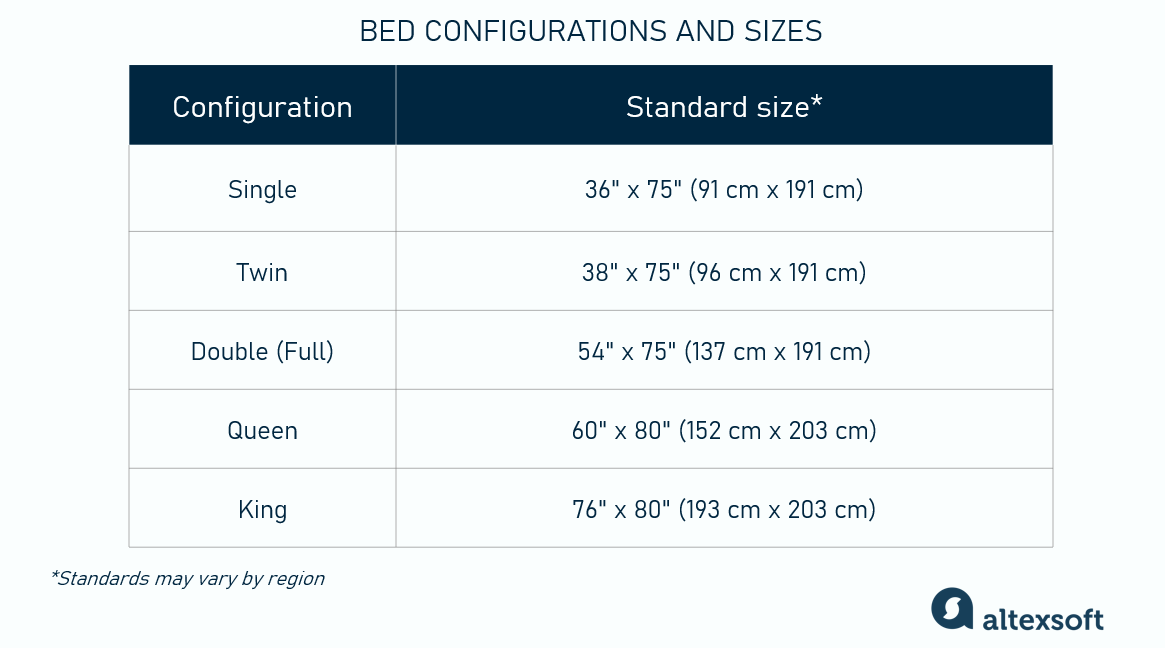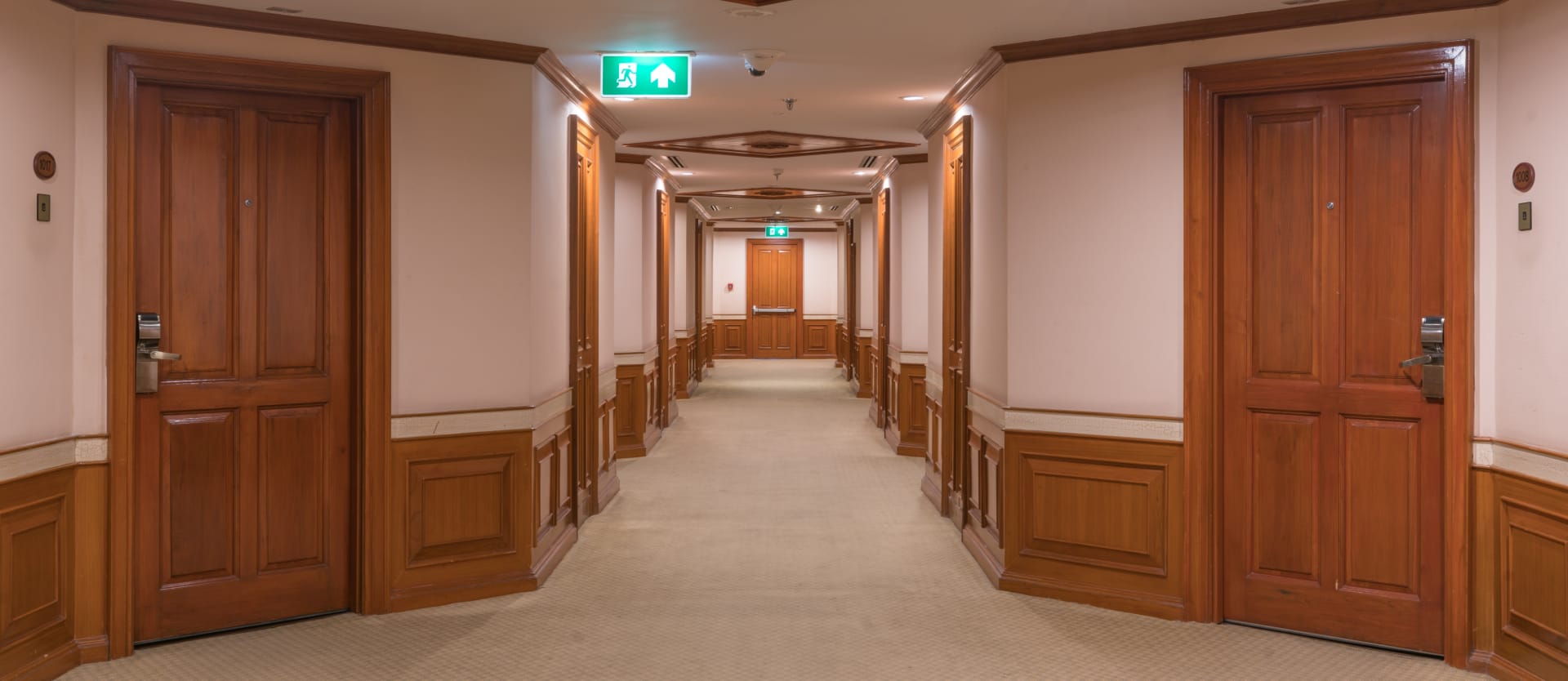Hotel room types may seem straightforward, but there’s actually a lot more to them than meets the eye. Do you really know the difference between King and Queen, Superior and Deluxe, or Connected and Adjacent rooms?
The hotel room is the core of guest experience and hotel revenue, so understanding its classification is vital. In this guide, we'll break down the most common hotel room types and what they mean for guests and properties.
What are hotel room types?
A hotel room type is a set of room features that helps guests understand what to expect from their stay. For hotels, room types serve as a basis for setting rates.
Essentially, the types of rooms a property offers reflect its overall business strategy. Every hotel creates a room mix that fits its target market and traveler segment: Different room types cater to different guests, from business travelers to families, and address diverse needs, from accommodating pets to extended stays.
Focusing on the right room mix is crucial for hotel operations, occupancy, and profitability. We’ll explore the impact of room types on revenue management right after we describe them.
So here are the main room classifications:
- occupancy (single, double, triple, quad);
- bed configuration (king, queen, twin, Hollywood twin, double-double);
- level of amenities (standard, superior, deluxe, suite);
- layout (studio, apartment-style, connecting/adjacent, cabana, villa);
- specific features (pet-friendly, smoking/nonsmoking, accessible); and
- purpose of stay and guest type (business suite, family room, honeymoon suite, etc.).

Hotel room types
Note that the classifications discussed here are common ways to organize hotel rooms, but they are not the only universally recognized methods in the industry. Different hotels, chains, and booking platforms may use alternative or additional systems.
Room types based on occupancy
One of the easiest ways to categorize hotel rooms is by the number of guests they’re meant to accommodate. It’s usually the first thing travelers look at to determine if a room fits their needs.
Single room
A single room is designed for one person. But since most hotels include double or queen-sized beds, a single room could also suit couples looking for a budget-friendly option.
This room type targets solo leisure travelers and individual corporate clients.
Double room
As the name suggests, this room is for two guests, but here's where it gets tricky. The bed setup can range from one large bed (like a queen or king) to two separate twin beds.
This lack of consistency can sometimes lead to confusion and disappointment for guests – if expectations are not managed carefully during the booking process. To avoid misunderstandings, it makes sense to be more specific with room names – like calling it a "Queen Room" or "Twin Room" instead of just "Double."
For most hotels, a double room in its various configurations serves as the bread and butter of the inventory, catering to the large market of couples and travel companions.
Triple room
This room type is meant for three guests and offers a variety of bedding configurations, such as three twin beds, a double bed with a twin, or even two double beds. To avoid confusion, the exact bedding arrangement must be made clear to guests before they book.
A triple room is a typical choice for families or small groups who want to stay together in one room rather than book separate ones, offering a more affordable alternative.
Quad/Quadruple room
Designed to comfortably accommodate four guests, this room often has two double or queen-sized beds, but resorts or family-friendly hotels may use bunk beds to save space.
Quad rooms are perfect for families with kids or small groups, like sports teams, looking for more space without breaking the bank.
Room types based on
Apart from how many people a room can accommodate, the size and number of beds are key factors in guest comfort and booking decisions. To make things clearer, many hotels now include the bed type in the room name on booking sites.

Bed configurations and sizes
Queen room
This room features one queen-sized bed, typically measuring 60 x 80 inches (152 x 203 cm). It’s a versatile option, ideal for solo travelers who want more space than a double bed offers or couples seeking a cozy, yet spacious, sleeping arrangement.
King room
With a king-sized bed (usually 76 x 80 inches or 193 x 203 cm), this room is designed to provide the utmost comfort. It's often marketed as a premium option, perfect for couples or individuals who want extra space and a luxurious feel during their stay.
Twin room
This room type features two separate twin beds, perfect for guests who aren’t traveling as a couple. This configuration is especially useful for business colleagues, friends, or family members who prefer their own sleeping space. Offering this option adds valuable flexibility to a hotel’s room inventory, catering to a wider range of guests.
Hollywood twin room
A unique variation of the twin room inherent mainly to Japanese hotels, the Hollywood twin has two separate twin beds that share a common headboard. This style offers a different aesthetic and a practical solution if guests want to push the beds together.
Double-Double room
This room features two double beds, although in modern properties, it's often two queen-sized beds. It's a popular choice for families or groups of up to four people, as it provides distinct sleeping areas for multiple guests in a single room, making it a convenient and budget-friendly option for people traveling together.
Room types based on the level of amenities
This classification focuses on the space and design, offering different levels of comfort and luxury depending on the guest's preferences.
Standard room
This is the most basic room type, providing essential amenities like a bed, bathroom, and minimal furnishings. It's designed to meet guests' basic needs, making it a cost-effective choice for those who just need a comfortable place to sleep and freshen up.
Superior room
A step up from the standard room, the superior room offers more space and upgraded amenities, such as a larger bed, better furnishings, and sometimes additional perks like a better view. It’s ideal for guests looking for a bit more comfort and value without opting for a full suite.
Deluxe room
A deluxe room offers extra space, high-end furnishings, and premium amenities. Guests may enjoy features like a larger bed, a more luxurious bathroom, and additional services such as a coffee maker or upgraded toiletries. This room is perfect for those seeking a more indulgent stay with additional comforts.
Suites: junior, presidential, and penthouse
Suites are the top-tier room category, typically offering a separate living area, larger spaces, and luxury amenities. Sometimes, they might even have a kitchenette or dining area. Suites are designed for guests looking for a high-end, spacious experience and are often used by families or business travelers who need extra space and privacy.
Junior suite. A smaller version of a suite, it still provides a higher level of comfort with premium amenities, such as upgraded furnishings, a larger bed, and sometimes a small sitting area.
Presidential suite. A presidential suite is the pinnacle of luxury accommodations. It typically includes multiple rooms, such as a large living area, separate bedrooms, and sometimes a dining area or office space. With high-end furnishings, exceptional design, and exclusive services (like a private concierge), this suite is designed for VIP guests, celebrities, or heads of state.
Penthouse. A penthouse suite also offers a luxurious and exclusive experience, but its key feature is the top-floor location. With expansive space, premium amenities, and sometimes even a private terrace or rooftop garden, a penthouse caters to high-end and celebrity guests.


Room types based on layout
This classification groups rooms based on their physical design and arrangement, helping guests choose a space that fits their needs and preferences.
Studio room
A studio room combines the living and sleeping areas in one open space, often featuring a bed, seating area, and a small kitchenette.
While featuring a simple, efficient setup, studios with basic cooking facilities give guests a self-sufficient feel.
Apartment-style room
An apartment-style room offers the comfort of a fully equipped living space, including separate areas for sleeping, dining, and cooking. These rooms typically feature a full kitchen, often with a stove, microwave, and refrigerator, as well as additional amenities like a larger living area or even a washer and dryer.
Apartment-style rooms are ideal for extended stays or for guests who need more space and flexibility, such as families or business travelers working remotely.
Connecting and adjacent rooms
Connecting rooms are two separate hotel rooms that are linked by an internal door, allowing guests to move between the rooms without using the hallway.
In contrast, adjacent/adjoining rooms are two hotel rooms located next to each other, but without a connecting door. While guests can easily access both rooms from the hallway, the rooms are not directly linked internally.
These setups are often chosen by families, groups, or colleagues who want the privacy of individual rooms -- but with easy access to each other.
Cabana
A cabana is a small, standalone structure typically found near a pool, beach, or resort area. Often open on the sides with a roof, cabanas offer a more relaxed vibe than standard hotel rooms.
Cabanas usually have comfortable seating, a small table, and sometimes a minibar or an outdoor shower. They're perfect for guests who want a blend of indoor and outdoor living, ideal for enjoying the sun and relaxing by the water. Cabanas are often used at resorts or luxury hotels catering to guests who want more than an ordinary experience.
Villa
A villa is a larger, more private accommodation option, often associated with luxury resorts or destination properties.
Villas typically feature multiple bedrooms, spacious living areas, a full kitchen, and sometimes a private pool or outdoor space. They provide guests with a high level of comfort, space, and exclusiveness during their vacation.
Room types based on special amenities
This approach categorizes rooms according to special attributes or accommodations, ensuring guests can find rooms tailored to their personal requirements or lifestyle.
Pet-friendly room
These rooms are specifically designed for guests traveling with pets, so they often include pet beds, water bowls, or easy access to outdoor areas for pet relief.
Hotels that offer pet-friendly rooms usually have policies in place, such as size or breed restrictions, and may charge an extra fee for guests traveling with animals.
Accessible room
Designed for guests with disabilities, accessible rooms are equipped with amenities that make the space easier to navigate, such as wider doors, grab bars in the bathroom, and lowered sinks or counters.
Smoking room
Smoking rooms are designated areas where guests can smoke indoors. In addition to ashtrays, these rooms have powerful ventilation systems to minimize the impact of smoke on other areas of the hotel and more robust cleaning practices.
However, smoking rooms are becoming less common as many hotels have moved to entirely smoke-free policies due to health and safety concerns.
By purpose of stay and guest type
Yet another way hotels can classify rooms is based on the type of guest they’re targeting or the purpose of the stay. This classification ensures that the room features and amenities align with the guest's needs and expectations.
Executive/Business suite
Designed for business travelers, these rooms cater to professionals who need space to work and rest. This type typically includes a large desk, ergonomic chair, high-speed Internet, a business center with office supplies, and often access to executive lounges or meeting rooms. The room may also have extras like a printer, fax, or coffee machine.
Family room
Created for families traveling together, this room type offers enough space and comfort for parents and children. It’s usually larger than a standard room and has multiple beds (such as two double or queen beds or a combination of beds and sofa beds).
Family rooms may include additional amenities like extra seating, child-friendly entertainment options, and sometimes a kitchenette or mini-fridge to accommodate family needs.
Honeymoon suite
Tailored for couples on their honeymoon, this room offers a romantic and luxurious environment to celebrate a special occasion.
A honeymoon suite typically has upscale amenities such as a king-sized bed, Jacuzzi, romantic décor, mood lighting, and views of scenic spots like the ocean, mountains, or city skyline. It may also offer in-room dining or special packages with drinks or spa treatment.
Hotel room type inconsistencies and how hotel mapping addresses this problem
One of the biggest challenges in the hotel industry is inconsistency in how room types are defined and labeled. A “Double Room” in one hotel might mean a room with two twin beds, while in another, it could mean a single large bed. Similarly, terms like “Superior,” “Deluxe,” or “Executive” can vary wildly between properties and hotel brands.
These inconsistencies often confuse guests, lead to unmet expectations, and create additional work for hotel staff handling complaints or room changes. To avoid these issues, hotels provide detailed room descriptions and clear policies for guests.
But that’s just one part of the problem. Another is the inconsistencies and duplications that occur when OTAs source information from multiple channels.
Hotel content mapping is the solution that addresses this problem. On the room level, mapping tools analyze the room data, standardize it, and remove repetitions. For example, a booking platform can map all rooms that accommodate two guests with one king bed to a “King Room” category, regardless of what the hotel calls it internally.
Please read about the hotel and room mapping in our dedicated post.
How room types impact hotel revenue
Room types play a huge role in revenue management by allowing hotels to optimize pricing, occupancy, and overall profitability.
Pricing. Room types are the basis for a hotel rate plan—basically, a tiered system of room rates. For example, premium options, such as suites or executive rooms, are typically priced higher, while basic, standard rooms have lower rates.
Then hotels can apply different pricing strategies to maximize revenue, like having various rate plans for different booking channels or seasons.
By offering different room categories and adjusting prices based on availability and demand, hotels can maximize their RevPAR – one of the main hotel KPIs.
Occupancy optimization. Offering a range of room types helps attract a wider audience. For instance, hotels with only standard rooms might miss out on bookings from larger groups or families who need more space. By offering suites, family rooms, or connecting rooms, hotels cater to various guest segments.
Cross-selling and upselling. Different room types allow for upselling and cross-selling opportunities. For example, guests booking a standard room might be offered an upgrade to a superior room or suite for an additional cost, increasing the hotel's revenue.
Also, when guests inquire about specific amenities or extra services (like larger beds, meal options, or paid amenities access), these can be bundled into higher room categories, creating additional revenue streams.
Enhancing guest satisfaction and loyalty. By providing a variety of room types, hotels can meet the specific needs of their guests, which leads to higher satisfaction. When guests feel their needs are met, they're more likely to return and recommend the hotel to others. Repeat guests contribute to steady revenue, and offering personalized room types helps build loyalty over time.



Maria is a curious researcher, passionate about discovering how technologies change the world. She started her career in logistics but has dedicated the last five years to exploring travel tech, large travel businesses, and product management best practices.
Want to write an article for our blog? Read our requirements and guidelines to become a contributor.

